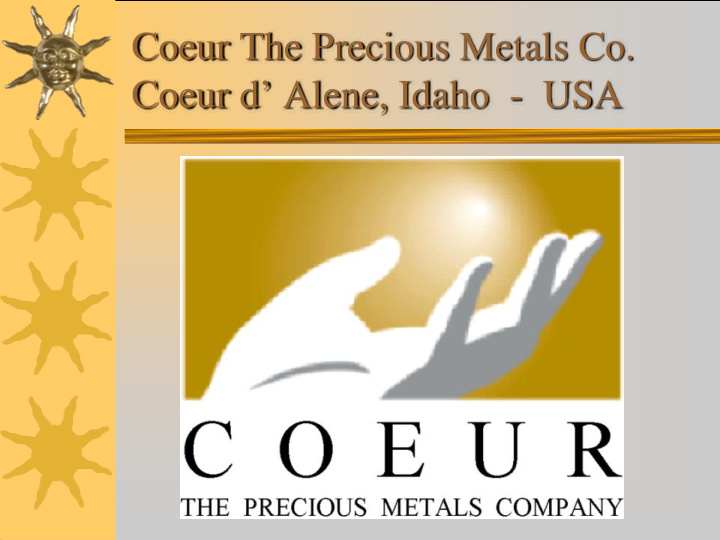



Coeur The Precious Metals Co. Coeur d’ Alene, Idaho - USA
Coeur Silver Valley Galena Mine David G. Turcotte C.M.S.P. Manager of Safety & Health Mine Rescue Coordinator Wallace, Idaho
Coeur The Precious Metals Co. Coeur d’ Alene, Idaho - USA
Idaho & United States of America
Home of Central Mine Rescue Coeur Mine –CSV
A Study of Heat Stress Exposures and Interventions for Mine Rescue Workers Floyd Varley Mining Engineer NIOSH Spokane Research Lab Spokane, Washington USA
Acknowledgements � Central Mine Rescue Association � Hecla Mining, Lucky Friday Mine � Coeur Silver Valley Resources, Galena Mine � Barrick Goldstrike Mines, Meikle/Rodeo Mines Fellow Researcher Patrick Hintz, CIH, NIOSH- SRL
Measuring Heat Strain CorTemp swallowable heat sensor pills Recorder, Alarm and Heart Rate Chest Strap
Measuring Heat Stress � Measuring the Mine Environment – WBGT heat stress monitors – Infrared readings of Surfaces – Air Velocity
Mine Rescue Workers -A Study of Exposures in the Mine Environment 30 mine rescue team members were monitored during underground exercises to bridge the gap between lab based studies and the miners.
Mine Rescue Exercise & Training
Teams Working – Drilling with a Jack Leg
Next Team – Getting Ready To Go!
What are the Effects of Elevated Core Temperature � Over 38 C (100.4 F) Performance in terms of Judgment and Reaction Times Begins to Diminish � At 38.5 ° C (101.5 F) - Physical Strain Has Begun …. The Person Is Moving Toward Heat Stroke
Five Man Team – Packing a Loaded Stretcher
Team Member with Water Bag
Mine Rescue Individual Results – 27C WBGT Temperature Change -Degrees C
Importance of Starting Temperature
The Impact of Fitness and Rest on Heat Retention Rates
Impact of Limiting Work Rate by Forced Rest Exercise in 27ºC WBGT – Rest in 15ºC WBGT
What Contributed to The Core Temperature Rise? 17% Task Apparatus 22% 61% Not Resting
Controlling Work Rate by Heart Rate
Planning Realistic Durations of Operations
Other Interventions & Results � Apparatus Type (with & without inhalation air cooling) - No Reduction in Core Temperature among approved apparatus.
Other Interventions & Results � Phase Change Cooling Vests - No Reduction in Core Temperatures for vests with up to 3 kg of coolent - Short term (30 minute) Reductions for vests with 6 kg if coolant.
Other Interventions & Results � Hydration Supplied Masks - Significant Reductions in Core Temperature as measured with the swallow able sensor – should be confirmed with other metrics in lab.
Other Interventions & Results � Hydration Supplied Masks - Testing only
Other Interventions & Results � Hydration Supplies Masks – Testing only
Other Interventions & Results � In Mask Temporal Artery Temperature Monitoring – In Progress – Appears to lead core temperature rise by 10 to 15 minutes – Potential for real time monitoring – Requires 10 to 15 minutes to equalize at start up
Recommendations: 1. Estimate potential heat exposures and plan training and emergency response activities based on the time guidelines developed in Europe and not on the apparatus duration alone. 2. Monitor team members for resting heart rate and starting temperature to exclude high risk team members. 3. Control the pace of activity by monitoring recovery heart rate during team checks. Add additional rest periods based on peak heart rates. Rest until all members are within 10% of their initial resting heart rate. Floyd Varley 509-354-8027 fvarley@cdc.gov
Main Entrance – Galena Mine Coeur d’ Alene Mining District
Coeur Silver Valley Galena Mine Thank You David G. Turcotte C.M.S.P. Manager of Safety & Health Wallace, Idaho-U.S.A. dturcotte@coeur.com
Recommend
More recommend